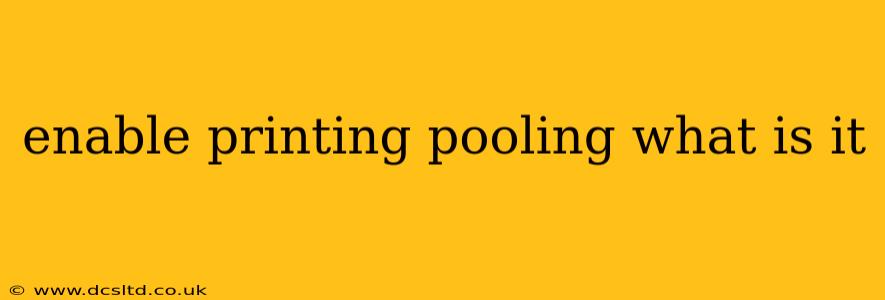Printing pooling, also known as print pooling or printer pooling, is a technology that allows multiple users to share a single print queue. Instead of each user having their own individual printer connection, all print jobs are sent to a central queue managed by a server. This server then distributes the jobs to available printers within the pool based on a variety of factors, such as printer availability, print job priority, and printer capabilities. This seemingly simple concept offers significant advantages for businesses and organizations of all sizes.
What are the benefits of enabling printing pooling?
Implementing printing pooling brings several key benefits:
- Cost Savings: Reduces the number of printers needed, leading to lower hardware purchase and maintenance costs. Consolidating printers also minimizes the amount of ink and toner consumed.
- Improved Efficiency: Centralized management simplifies printer administration and maintenance. IT staff can easily monitor print jobs, troubleshoot issues, and manage printer settings from a single location.
- Enhanced Security: Centralized management allows for better control over access to printers, implementing security measures like authentication and authorization to restrict printing privileges.
- Increased Productivity: Users experience less downtime due to printer malfunctions. If one printer goes down, other printers in the pool can pick up the slack, ensuring uninterrupted workflow.
- Simplified Management: Managing a pool of printers is significantly easier than managing individual printers scattered throughout an office. Software solutions often offer centralized management tools for monitoring usage, managing settings, and resolving issues.
- Optimized Resource Utilization: Print jobs are intelligently routed to the most appropriate printer, optimizing the utilization of available resources and minimizing idle time for printers.
- Better Scalability: Adding new printers or users to the pool is relatively straightforward. This makes it easy to adapt to changing needs and growth.
How does print pooling work?
Print pooling typically involves a print server acting as an intermediary between users' computers and the printers. When a user sends a print job, it's directed to the print server. The print server then determines which printer is best suited to handle the job based on its pre-configured rules and the current status of the printers in the pool. These rules can include things like:
- Printer type: Ensuring color jobs are sent to color printers and black and white jobs to monochrome printers.
- Printer availability: Routing jobs to printers that are currently online and not busy.
- Printer location: Sending jobs to the nearest printer to minimize delays.
- Job priority: Giving priority to urgent print jobs.
What types of printing pooling solutions exist?
Several methods exist for implementing print pooling, ranging from simple network configurations to sophisticated software solutions. These solutions can range from basic, built-in functionalities in operating systems to dedicated print management software designed for large enterprise environments.
What are the potential drawbacks of printing pooling?
While print pooling provides many benefits, there are some potential drawbacks to consider:
- Initial Setup Complexity: Implementing print pooling, particularly in large organizations, can require significant upfront effort and configuration.
- Software Costs: Dedicated print management software can add to the overall cost, particularly for larger organizations.
- Dependency on Network Infrastructure: The effectiveness of print pooling relies heavily on a reliable network infrastructure. Network issues can impact the availability and performance of the print pool.
- Troubleshooting Challenges: Troubleshooting print-related issues can be more complex in a pooled environment, requiring a deeper understanding of the print server and its configuration.
Is printing pooling right for my organization?
Whether or not printing pooling is suitable for your organization depends on several factors, including:
- The size of your organization: Larger organizations with numerous printers and users often benefit most from print pooling.
- Your IT infrastructure: A stable network infrastructure is essential for successful print pooling implementation.
- Your budget: Consider the costs of software and potential hardware upgrades.
- Your security requirements: Print pooling can enhance security if properly configured but might require extra investment in security measures.
By carefully weighing the pros and cons, and assessing your organization's specific needs, you can determine if enabling printing pooling is the right solution for your printing environment. A thorough evaluation of your current printing infrastructure and future requirements is recommended before making any changes.
